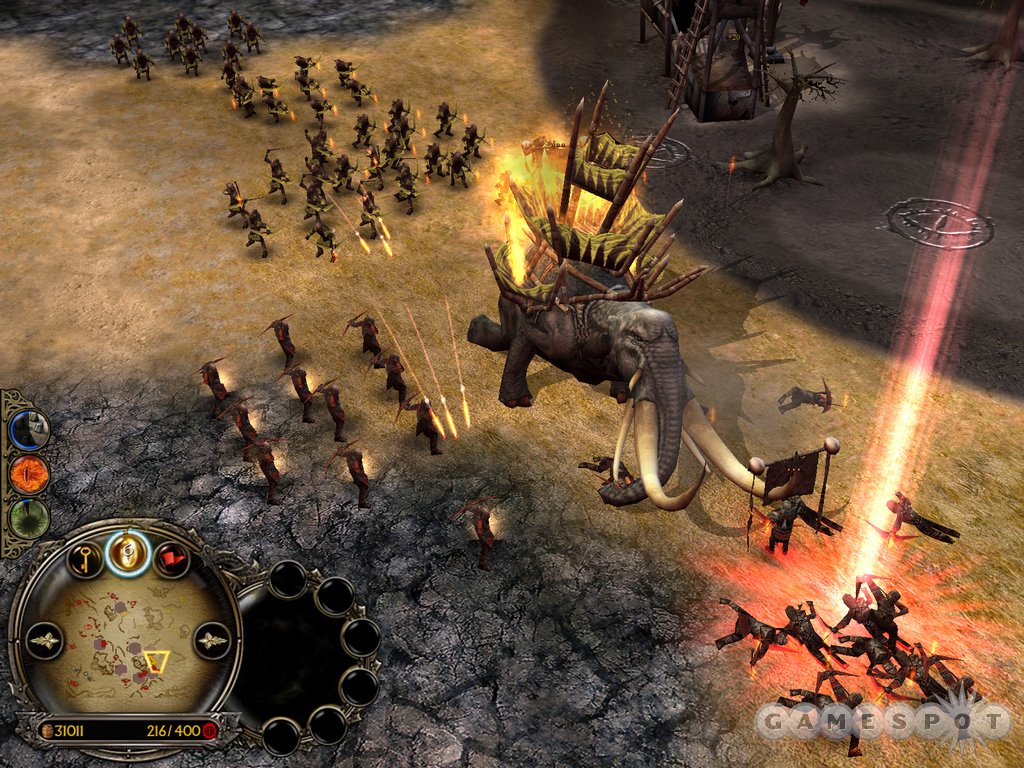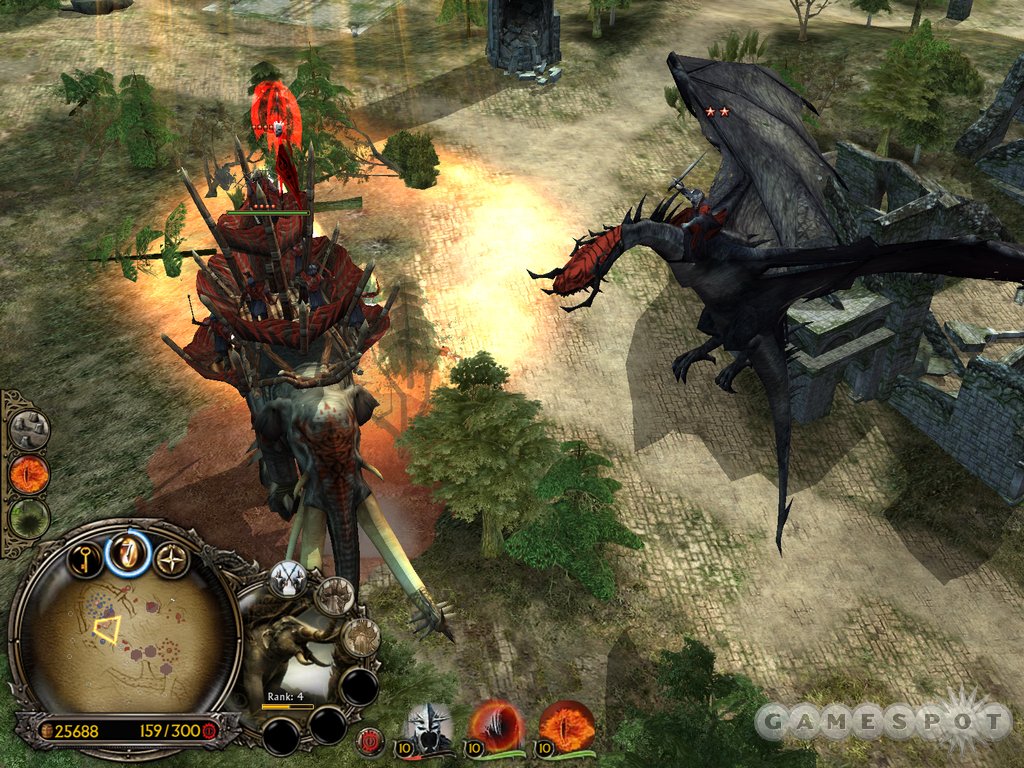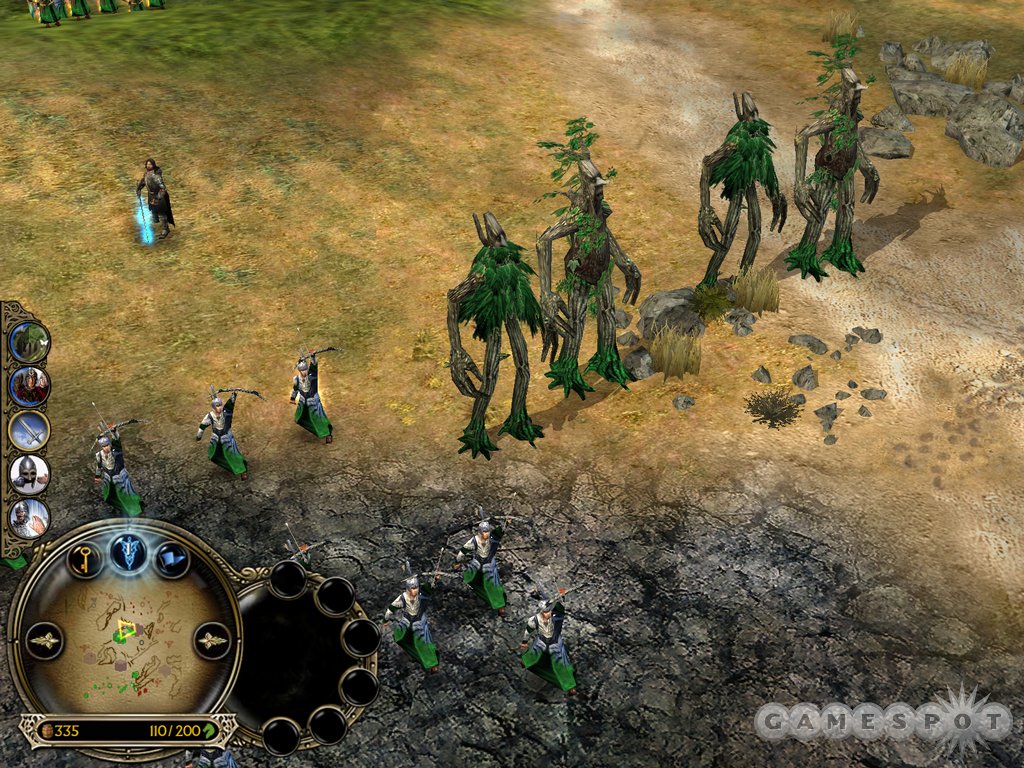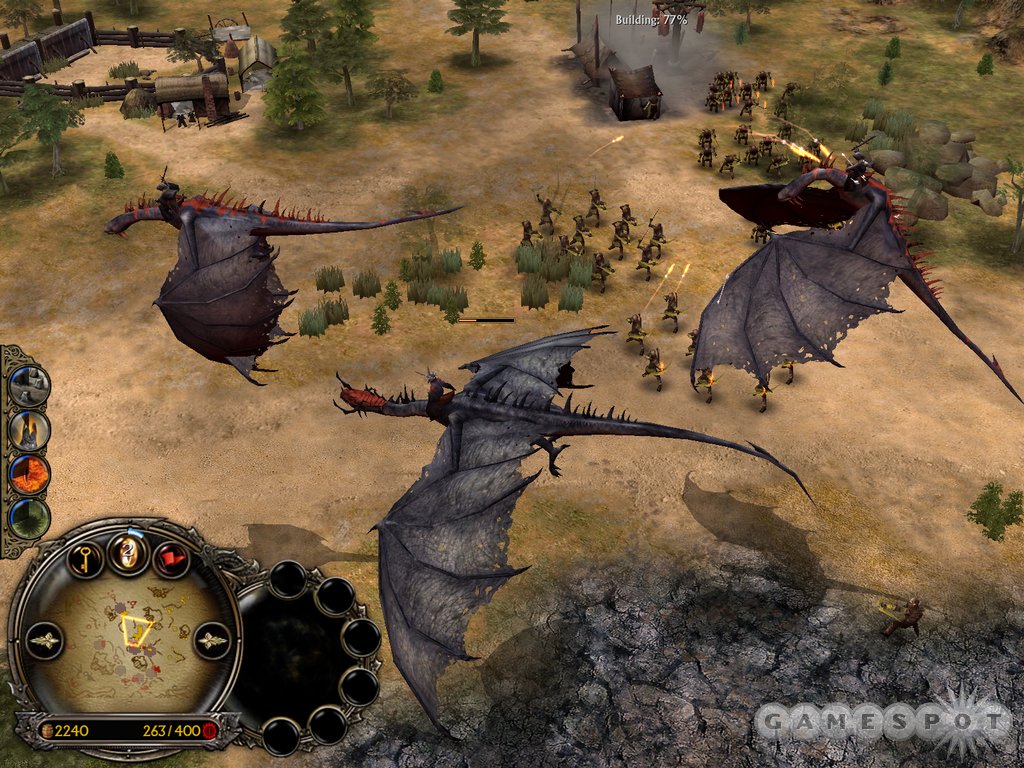The Lord of the Rings, The Battle for Middle-earth Updated Hands-On - Multiplayer Impressions
We sally forth into some grueling multiplayer matches with a few of EA LA's finest, and after taking a sound beating, we have many [non-beating-related] details to report.
Historically, most real-time strategy games pretty much went something like this: collect resources, build up a base, and win the game by recruiting a game-winning, opponent-crushing army first. A lot has changed in recent years, thanks to the Command & Conquer series, which was among the first to emphasize fast-paced, offense-minded strategy over spending the first part of a game session on less-than-exciting tasks like mining gold and chopping wood. The creators of some of the most popular games in this series are now putting the finishing touches on EA LA's The Lord of the Rings, The Battle for Middle-earth. According to designer Mark Skaggs, the game's single-player campaign, which takes place in the sprawling fantasy realm of the award-winning The Lord of the Rings motion pictures, will "attempt to tell a story in the The Lord of the Rings universe using real-time strategy as a venue." However, as we found out firsthand, it will also be a brutal and unpredictable multiplayer game in which one last-second decision can seemingly turn the tide of battle at practically any moment. (Hint: This can actually work against you if you're playing against the company that created the game). Read our impressions here, and be sure to watch the latest exclusive "what if?" trailer, along with all-new gameplay movies.

If you've been following the game's progress so far, you'll know that it features four playable factions, each with its own set of military units, special powers, and "hero" units. These are: the noble defenders of Gondor; the uruk-hai legions of Isengard, domain of Saruman the White; the nomadic riders of Rohan; and the orc hordes of Mordor led by Sauron himself, whose fearsome gaze can be used as an actual weapon in the game. It's true that some of the sides share a few common units (for instance, the mighty wizard Gandalf has been known to come to the aid of both Rohan and Gondor), many of which are arranged in grouped companies, rather than as single units to micromanage. Still, each of the four sides seems to follow completely different strategies that appear to be in line with their roles in the motion pictures--it doesn't hurt matters that the game uses unit portraits and voice samples that come right out of the movies, either.
And the four different factions should collectively provide at least one good choice for most any real-time strategy fan, which will even provide surprising variety in and of themselves, because the four factions each not only have different heroes, but also different "special powers" that can have minor effects or dire consequences. You'll earn "battle points," which you'll obtain by defeating your enemies and destroying their structures. You can then use these points to purchase various powers from a branching tree of special powers, which grow successively stronger until you unlock each side's most expensive and most devastating power, such as Mordor's summoning of the dreaded balrog demon. In addition, the game doesn't have a traditional "technology tree." Yes, you start the game with handful of units and a central citadel structure from which you can hire heroes, but instead of having to build and upgrade buildings in a certain order to gain access to specific units and specific strategies, in many cases, you can build whichever unit-producing building you want, provided you have enough of the game's single, unified resource to afford it.
And you can build as many units as you want within your maximum population (or "population cap"). Like with other strategy games, this one limits your population based on your holdings, though the game also seems to have some very creative ways to push this limit. That is, although your maximum population cap in multiplayer is invariable, you can reach it more quickly by building farms or slaughterhouses that provide larger amounts of food to allow for larger forces. These structures can be built either at your starting base, or at expansion points on the map that can allow for either a single farm/slaughterhouse or a larger outpost that can sustain three additional nearby structures (though these structures are generally much harder to defend). So, if you're patient enough, you can sit and wait for your structures to generate enough resources so that you can afford to build a troll pit to commission the bulky behemoths right off the bat. Unfortunately, given the fast pace of the game, your opponents won't always let you wait that long. Meanwhile, all units and all buildings automatically gain "veterancy" by increasing in rank and power the more they're used. A single structure that creates many units will eventually upgrade itself to produce better versions of that unit, while units that defeat many enemies will also gain veterancy and become more effective in battle. Unit veterancy can come from defeating your opponent's forces, as well as from defeating neutral creatures holed up in lairs on the game's different maps.

The proud human soldiers of Gondor are perhaps the most straightforward of the four factions to play. Gondor seems to possess the archetypal military units you'd expect from a medieval-themed game, including swordsmen, archers, cavalry, and siege engines. However, these warriors begin the game with a considerable advantage: their starting fortress is enclosed in a thick, stone wall (similar to that of Helm's Deep in the motion picture The Two Towers). This wall begins with only one entrance, which is a huge wooden gate that can be manually opened and closed. Additional doors may be built, but they can only be used by the Gondor player, not by enemies. The walls of Gondor can even be fortified by mounted trebuchets, which hurl massive stones at enemies that shatter with a massive impact. But these stationary weapons are ripe targets for the game's many countermeasures. Gondor's basic infantry swordsmen can be upgraded to the heavily armored tower guards, which can be formidable on the battlefield with the right upgrades and when accompanied by the right hero, including the brothers Boromir and Faramir, along with Gandalf and the hobbit Peregine "Pippin" Took. Gondor seems to possess a well-balanced set of special powers, including an instantaneous healing spell and the summoning of reinforcements in the form of Rohan emissaries or elven archers.
The Battle for Middle-earth Is About to Begin
The forces of Sauron in Battle for Middle-earth, on the other hand, possess a different kind of strength: strength in numbers. They don't have much in the way of defensive powers, but not coincidentally, they do have many abilities and forces that stress offense over defense, including one very obvious perk: free orcs. Provided they have a large enough population allowance (within the maximum population cap), Mordor players can churn out orc company after orc company after orc company. These are limited only by the time it takes to create them and by your population cap. As it turns out, these restless grunts can actually "contribute" to your cause in other ways by either turning on another of your orc companies and killing it off to gain veterancy, or by serving as emergency snack food for Mordor's lumbering trolls, which fully recover from their injuries after devouring one of their comrades. These huge brutes (which first appeared in the motion pictures in the mines of Moria--one nearly killed Frodo) are terrifying in battle for their ability to slaughter whole groups of infantry units with a single swipe of their paws. But in a pinch, they can also be converted into slow-moving ranged units or even siege units when ordered to either pick up the nearest boulder (to hurl at enemies) or to uproot the nearest tree (to use as a club). Mordor's ranks can be supplemented by heroes like the cowardly (and inexpensive) Gollum, who has no real offensive power but is an excellent scout, and by nazgul riders (including the immortal witch king), whose winged mounts give them easy access to enemy buildings even behind walls, and whose unearthly wails strike fear (and combat penalties) into the hearts of their enemies. The Mordor faction seems very well-suited for players that favor aggressive strategies, like churning out orcs to capture expansion points early in the game. This strategy will raise your maximum population towards the cap and bring in resources quickly so that trolls and nazgul can be brought into play as soon as possible.

The riders of Rohan, on the other hand, have been described by several of the game's developers at EA LA as "the finesse side"--a faction that relies less on brute force of numbers and much more on talented heroes with tide-turning abilities that, if used at just the right moment, can make the difference between victory and defeat. Of the four sides in the game, Rohan has access to the largest number of heroes for hire, including, among others, the royal line of Rohan (King Theoden, his banished nephew Eomer, and his valiant niece Eowyn), along with the legendary heroes of the fellowship of the Ring (Legolas, Gimli, and Aragorn). Rohan possesses the strongest cavalry units in the game--like with other cavalry units (such as the knights of Gondor), these skilled equestrians can kill some infantry battalions outright by smashing into them with a charge (and Rohan can also commission horse archers for ranged attacks with added mobility). But the faction's greatest strength is clearly its great variety of heroes and special powers, such as the army of the dead--the massive mob of ghostly soldiers that was called forth by Aragorn in The Return of the King to decimate the hosts of Mordor.
The game's fourth faction, the host of corrupted Isengard, is by no means any less impressive than the others, and it is arguably the strongest faction in the game in terms of raiding strategies. Isengard's primary forces are the bizarre humanoid monsters known as uruk-hai, which may be commissioned as infantry grunts or crossbow archers from the very same structure. These creatures seem roughly comparable in power to the basic foot soldiers of the other factions, but they travel at an alarmingly fast sprint, which can help the forces of Saruman gain an early lead by quickly seizing nearby expansion points and by staging quick raids on enemy territory. When fully upgraded (built from a top-level "veteran" structure and supplemented by purchased upgrades), uruk-hai can be a force to be reckoned with. For instance, we ourselves experienced surprising difficulty against fully upgraded uruk-hai crossbow archers with fire arrows that cut down slower units before they could even be reached. However, we found that although trolls and foot soldiers were too slow to reach these archers before getting feathered with arrows, properly supported cavalry units smashed right through their ranks, and apparently, siege units (which have longer ranges and longer lines of sight) can also make short work of them. We were assured by EA LA's developers that although Battle for Middle-earth offers plenty of special powers and military units that can seem overwhelming at first, there are countermeasures for all of them. You may have trouble believing that when going toe-to-toe with the mightiest of Isengard's few heroes, Saruman the White, whose devious "wormtongue" ability (which was used to subdue and control King Theoden in The Two Towers) can seize control of several of your own battalions and turn them against you. However, it's easier to swallow when you can counter with a fully upgraded Gandalf the White in your retinue, who possesses three different kinds of highly damaging sorcerous attack spells in addition to his many other abilities.
While we've seen and heard a great deal about the game's "living world" approach to creating an involved single-player campaign, what we've seen (and played) of the multiplayer suggests that the game will also be just as exciting and competitive--and almost as fast paced as EA LA's previous Command & Conquer: Generals games. Design director Dustin Browder suggests that, although multiplayer sessions probably won't end in three minutes, a complete shutout of a poor player against a highly skilled player may take about 15 minutes, while most multiplayer sessions will take between an hour to an hour and a half. While the different sides do seem to allow for different play styles, Browder states, emphatically, "You do not want to 'turtle up' too long in this game," referring to the practice of cowering within your own base and quietly building up your forces rather than sallying forth and doing battle early. Browder explains that the game's exceptionally powerful high-level units and heroes can provide a very effective deterrent to sitting back and waiting, since leaving your opponents in peace gives them the opportunity to expand quickly and commission bigger and more-experienced armies than yours.

However, the game's high-level special powers and hero abilities can also help turn the tide of battle. Browder and EA LA's team of developers have always intended for the game's multiplayer to be so unpredictable that even a player with a nearly destroyed base and only a handful of remaining units can turn the tide of battle and even win the day with the well-timed use of a special power. Based on our experience, they might just succeed. The game already has good-looking 3D graphics and seems to run at a brisk frame rate, even when huge armies are onscreen. Its use of voice samples from the motion pictures, along with its orchestral soundtrack, seem to help bring the flavor of the movies to the game. If what we've seen is any indication, The Lord of the Rings, The Battle for Middle-earth will offer highly compelling, highly competitive multiplayer to go with a very impressive single-player game. It won't be long before we'll all be playing it either, since the game ships in December.
Got a news tip or want to contact us directly? Email news@gamespot.com
Join the conversation